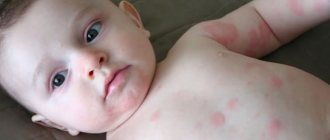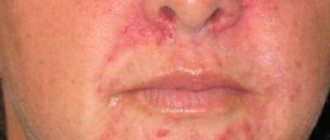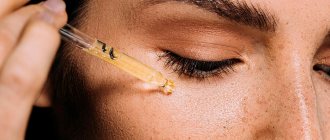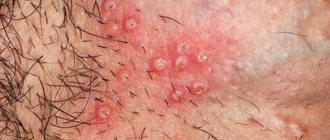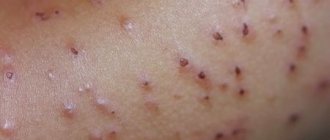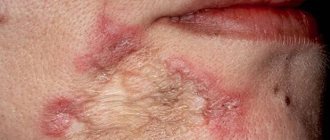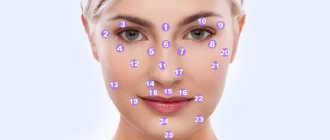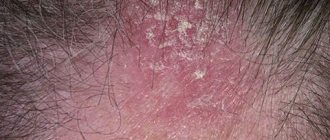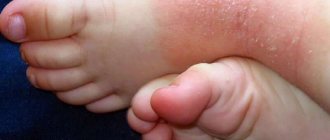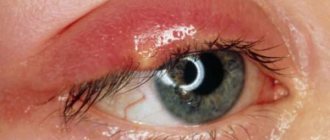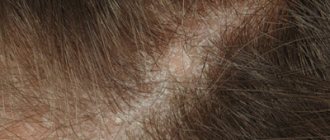Obvious signs of liver dysfunction are skin manifestations. When the hepatocytes of an organ die and do not have time to recover, the gland cannot cope with cleansing the blood, so waste and toxins circulate throughout the body. The result of intoxication in liver diseases is skin rashes, itching, discoloration, the appearance of small hemorrhages, and pigmentation disorders.
Which doctor should I contact?
If symptoms similar to those listed in the article appear, you can first contact a therapist who will prescribe tests and additional research methods. The patient is then referred for consultation to a gastroenterologist. If possible, it is advisable to make an appointment with a specialist in liver diseases, a hepatologist. Additional consultation with an oncologist or infectious disease specialist (for viral hepatitis and parasitic diseases) may be required.
First signs of liver disease
Fatty liver: symptoms, treatment and prevention
Symptoms of the disease
As a rule, hepatic erythema of the palms in adults (photo) appears symmetrically on both palms and has clear outlines. Peeling and burning (as with dermatological diseases) are not observed. In addition, the following signs may be present:
- when you press on the area of redness, a light pink mark remains;
- mild soreness may be present;
- the appearance of spider veins;
- periodic itching;
- a feeling of heat on the affected palms and soles, a local increase in temperature.
Depending on the underlying factor, the clinical picture will be supplemented with specific signs. If such disorders occur, you should seek medical help and not self-medicate.
Ignoring such a symptom or self-medication can lead to the development of serious complications, including death.
Causes of diseases
The liver has tremendous potential. It is very resistant to harmful factors. In addition, it has the ability to recover. However, liver disease can develop as a result of certain factors. Symptoms on the skin are the first signal that the organ gives to know about the development of pathology. Before considering them, let’s look at what can become a source of disease:
Viral agents. They provoke inflammatory processes in the liver, in acute or chronic form. As a result, a person develops hepatitis. Toxic effects. A constant supply of harmful compounds (heavy metals, vapors, chemicals) can lead to organ damage. Such a clinic is also observed after simultaneous exposure to high doses of toxic substances. Medicinal influence. Some medications have quite an aggressive effect on the liver. These are hormones, antibiotics and chemotherapy drugs. Alcohol. Abuse of alcoholic beverages has a detrimental effect on liver cells. As a result, cirrhosis may develop. Parasites and infections. The most destructive to the organ are: roundworms, alveococcus, echinococcus, and the causative agent of leptospirosis. They can become a source of pathological changes and provoke cystic transformation of the organ. Improper nutrition. Abuse of fried, fatty, smoked foods and spices leads to disruption of the outflow of bile. As a result, stones may form in the ducts. Heredity. Developmental defects and genetic diseases often underlie the occurrence of pathologies. Acute diseases in the abdominal cavity. Suppurative processes can spread to the portal vein. As a result, thrombosis occurs. Abdominal injuries. The consequences can appear even several years later, after suffering blows or injuries. Sometimes cysts or fluid accumulations are found in the parenchyma of an organ. Ionizing radiation, chemical carcinogens. This exposure can become a source of cancerous degeneration of areas of the liver.
Liver functions
The liver performs more than 500 functions in our body! This organ is involved in almost all processes, which is why it is often called a “chemical factory.” The main function of the liver in our body is to cleanse the blood. It neutralizes all toxins and harmful substances that enter the body with food and are then absorbed into the blood through the intestinal walls. All allergens and toxins are broken down by enzymes into less harmful and quickly excreted substances.
But, in addition to cleansing, the liver performs a number of important functions. Among them:
- Production of bile, which plays an important role in digestion.
- Regulation of metabolism (metabolic process). It takes part in the metabolism of proteins, fats and carbohydrates, and also secretes bile acids, due to which vitamins enter the intestines.
- The breakdown of hormones, as well as the normalization of hormonal balance in the body.
- Synthesis of substances that take part in blood clotting processes.
- Participation in the process of hematopoiesis.
- Regulation of water-salt metabolism (retains chlorine, iron and bicarbonates).
- Storing the body's energy reserves.
- Participation in the process of immunomodulation.
- Synthesis and breakdown of histamine, which is a regulator of allergic reactions.
The liver takes part in almost all the most important processes in our body. That is why disturbances in its functioning quickly manifest themselves, primarily in the form of skin changes. So let's look at how the liver affects the skin of the face and neck.
Watch a video about how the liver works and how the processes occurring in it affect the skin of the face:
Signs of pathologies
As a rule, liver disease is accompanied by skin symptoms. It is, first of all, a yellowish tint. In addition, the patient experiences heartburn and feels nauseated. There is a sharp, extremely unpleasant odor of sweat. Therefore, typical cases do not cause difficulties in diagnosis.
In most cases, a doctor can already visually suspect liver disease. Skin symptoms and the patient’s discomfort give the doctor an idea of the nature of the pathology.
The main signs of liver diseases are:
pain, feeling of discomfort in the organ area; liver enlargement; general malaise, weakness; headache; impaired thinking, mental abilities; swelling; increased sweating; jaundice; skin itching; rash; increased tendency to bleeding, fragility of blood vessels; symptoms of hypovitaminosis; discolored , the nature of stool, unstable stool; the presence of a venous pattern on the abdomen; weight loss; increased abdominal size; bitter taste in the mouth; temperature reaction; cracks in the tongue, white or brown coating on it.
Nature of pain
Most organ pathologies are immediately reflected on the human body and face. This allows you to promptly suspect liver disease. Skin symptoms are often accompanied by painful discomfort. The nature of the sensations can be quite different. Therefore, you should pay attention to the following discomfort:
The occurrence of minor pain in the right hypochondrium. It can be aching and bursting. Or give a feeling of heaviness. This pathology signals a sluggish process of inflammatory, toxic origin. Discomfort often occurs as a result of organ enlargement or stretching of the liver capsule. As a rule, the patient cannot clearly identify the pain point. Intense, widespread discomfort in the right hypochondrium. This kind of pain is rare. It signals a pronounced purulent, inflammatory or traumatic process. Sometimes it can be characterized by stone damage to the bile ducts. Local, severe point pain in the liver area. Discomfort is not typical for liver damage. It is associated with pathology in the gallbladder or extrahepatic ducts.
Sometimes the patient does not experience pain, but meanwhile develops liver disease. Skin symptoms are the only signs that indicate pathology. As a rule, the absence of pain is observed with indolent diseases that go undetected for a long time.
Liver pigmentation
Against the background of deteriorating liver functionality, pathological transformations in the concentration of melanin in the dermis layer are revealed, as a result of which spots are formed.
Melanin is a pigment substance, the synthesis of which is disrupted when the functioning of the gland deteriorates. When a substance accumulates in the dermis, the component settles in some areas, which change the natural color.
Most often, the localization of pigmentation is the face, neck, upper limbs, and shoulders. As liver disease progresses, the spots increase in size and affect new areas of the skin.
Causes of liver spots on the face
In a healthy body, melamine is distributed evenly, and the formation of small birthmarks or freckles is rarely noticeable. When the pigment concentration increases or decreases, spots of dark or light color are formed.
Causes include age, excessive exposure to ultraviolet rays, hormonal imbalance (for example, during pregnancy, endocrine disorders). Other provoking factors are menopause and the effect of chemicals on the skin.
When spots form during pregnancy, or due to a chemical burn, in most cases they disappear on their own.
The spots themselves do not pose a danger; they are only a cosmetic defect, as a result of which the color of the dermis has changed. If the spot enlarges, hurts, itches or bleeds, you should contact a dermatologist-oncologist.
Pigment spots due to the liver appear due to various diseases. Thus, darkening of the dermis occurs with the following diseases in men and women:
- Hepatitis of various origins. Against the background of pathology, the structure of the liver and functionality are disrupted, which worsens the condition of the skin. Brown or burgundy spots form on the surface of the body, ranging in size from 1 mm to 10 cm. Additional symptoms are swelling, urticaria.
- Parasitic liver diseases (leptospirosis, ascariasis, echinococcosis, giardiasis). The waste products of helminths are toxins for the human body. They provoke a severe allergic reaction, inflammation in the dermis, and disrupt liver function. Brown and red spots appear on the body. The most common location is the abdomen. In addition, there are other signs of invasion - pain in the abdomen, pain in the right side, loss of appetite, weakness, insomnia.
- Liver cancer. Liver spots on the hands appear not only due to age, but may also indicate the development of liver cancer and metastases in the digestive system. Symptoms are constant weakness, increased body temperature, decreased appetite, increased gas formation, and abdominal discomfort. In severe cases, the tumor can reach large sizes and compress the bile ducts, which leads to yellowing of the skin and itching.
- Alcoholic, viral or congestive form of cirrhosis. Liver damage is most often observed in alcoholics. In addition to liver spots, other symptoms are detected - multiple acne formations, a characteristic yellow coating on the tongue, a change in the color of the visible mucous membranes and the whites of the eyes.
- Gastrointestinal pathologies. With chronic disorders, brown spots on the face or other part of the body are not the only symptom. Patients complain of an unpleasant taste in the mouth, weight loss, rash, and dry skin.
Spots can go away if they are associated with a certain condition, for example, their appearance during pregnancy or during menopause - a temporary phenomenon, in most cases the skin clears itself.
When the cause is liver pathology, then eliminating stains is a complex process, since it is necessary to influence the cause so that they do not reappear.
Skin manifestations
The nature of the body cover can provide information about the functioning of various organs. This also applies to pathologies such as liver disease. Symptoms on the skin (the photo demonstrates these manifestations) can be quite varied.
The patient should pay attention to the following changes in the epidermis:
Pale or, on the contrary, dark skin. Quite pronounced sweating. There is swelling of the subcutaneous tissue in the area of the limbs and face. Flaky, dry epidermis. There are many scratches and cracks on the surface. Increased susceptibility to allergic rashes, psoriasis, atopic dermatitis, eczema. Jaundiced skin. This type allows you to determine pathology. With moderate yellowness with an orange tint, liver problems are diagnosed. With mechanical damage to the organ, a brown tint is observed. Lemon yellow color indicates hemolytic pathology. Presence of stretch marks. Striae are localized in the abdominal area. They often appear as bluish stripes. Stretch marks occur as a result of hormonal imbalance when the liver can no longer detoxify excess steroid hormones.
Treatment of age spots in liver diseases
Before removing stains using a laser or specialized drugs, it is recommended to visit a doctor and examine the liver and gastrointestinal tract for pathological processes. Leveling the external defect does not in any way affect the root cause of its appearance; the likelihood of relapse is high.
Elimination of the cause of occurrence
When the cause of pigmentation on the face is liver disease, the spots will appear again and again after each removal. It is necessary to look for the cause and influence it. When you get rid of liver disease, the spots may go away on their own.
To find the cause, you need to undergo a series of examinations - laboratory tests of blood, urine, feces and instrumental studies - computed tomography, ultrasound, MRI, fibroscanning (if cirrhosis is suspected), biopsy.
Cryodestruction
Cryodestruction helps to get rid of liver spots - the elimination of pathological elements with the help of vital nitrogen. For complete removal, 1-2 procedures are enough.
The process is as follows: the doctor applies liquid nitrogen to the spots with a special sprayer or cotton pad.
Advantages of the technique:
- Fast stain removal, easy technique.
- No blood or tissue scarring.
- A painless option to fix the problem.
- Minimal trauma.
- No special care is required after the procedure.
The disadvantages of cryotherapy include fairly long healing - within 3 weeks, and the presence of contraindications.
Photorejuvenation
Phototherapy is an effective and modern way to get rid of pigmentation.
According to the description of the procedure, the skin is exposed to impulses that destroy melamine accumulations.
Radiation is completely safe for humans. After manipulation, the treated area darkens, then exfoliates, is renewed, and the shade is evened out.
Advantages of photorejuvenation:
- Safety. Phototherapy does not injure tissue, so the formation of scars and the addition of an infectious process are excluded.
- Painless. During treatment, the patient feels a slight burning or tingling sensation. In case of severe pain, it is possible to numb the treated areas.
- Short recovery period. After phototherapy, you should not be in the sun or use cosmetic creams. Recovery takes 3-5 days.
- Productivity. You can remove a stain of any size, regardless of location.
Since the liver and facial pigmentation are related, phototherapy cannot guarantee 100% recovery if the diseased gland is not treated.
Laser removal
Modern laser treatment helps to get rid of even the darkest stains; the procedure is carried out by a doctor. The removal process includes several steps:
- A special preparation in the form of a gel is applied to the surface of dark areas, which ensures close contact between quantum rays and the epidermis.
- The affected area is irradiated using a laser.
- An antiseptic solution is applied to the treated area.
- To prevent scar formation and speed up regeneration, cover the treatment site with a sterile bandage with antiseptics.
The technique has contraindications - mental disorders, elevated body temperature, malignant neoplasms, pathologies of the cardiovascular system, organic lesions of the central nervous system.
Folk remedies
Unconventional methods help clear the skin of stains that appear due to liver disease.
The following home cleansing options are effective:
| Sorrel | A compress of fresh sorrel whitens the skin. It is necessary to grind it into a pulp, put it on a gauze napkin, and apply it to the affected area for 15 minutes. The manipulation is repeated every 2-3 days until the defect disappears completely. |
| Avocado | Herbal ingredients effectively whiten the skin. Rub the pulp into age spots. |
| Lemon + egg white | Mix lemon juice with egg white in equal proportions and apply to the affected areas using a cotton pad. |
| Vinegar + onion | Onion juice and vinegar are mixed in equal proportions. The liquid is applied to age spots once a day. |
| Elder | You need to pour a tablespoon of dry plant into 200 ml of boiling water, leave for 5 hours, filter 2 times. The resulting solution is used for compresses - 2-3 times a day for 15 minutes. |
| Chickweed | A decoction is prepared based on the plant, and the affected areas are wiped with it several times a day. |
Characteristic rash
The development of pathology can be signaled not only by changes in the skin. Many patients experience various rashes.
Sometimes the following symptoms occur:
Pustular elements. There is a tendency to form furunculosis and folliculitis. The source of such rashes is an immune imbalance. It occurs as a result of decreased liver function. The organ is not able to synthesize immunoglobulin in sufficient quantities. Allergic manifestations. This pathology in most cases characterizes liver disease. Skin symptoms: spots and papules, occur as a result of a violation of the detoxification function of the organ. That is why a person is faced with the occurrence of allergic reactions to familiar conditions. Hemorrhagic rash. Minor hemorrhages are observed on the surface of the skin. They are called petechial eruptions. They characterize a decrease in the synthetic function of the organ. Initially, the protein contained in the blood suffers. As a result, patients have an increased tendency, even with the slightest damage, to form hematomas.
The relationship between rashes and diseases
Indicators of the health of internal organs are “assigned” to each area on the face in case acne appears there. Based on the location of acne, one can judge the disease not only of the liver, but also of another organ. Often the gland also undergoes dysfunction in the presence of chronic or acute pathology in another organ. A rash on the forehead indicates problems with the ovaries, and if they are closer to the hairline, an exacerbation of chronic gastritis or gall bladder. Pimples above the eyebrows indicate poor bowel function. If the rash is profuse, it can be caused by the use of medications, hormonal agents or vitamins in large quantities. A rash on the nose means that there are hormonal imbalances or problems with the cardiovascular system.
Pimples on the chin indicate the appearance of tumors on the genitals. A rash indicates thyroid problems. If the rash is on the lips, on the shoulders, this is a sign of disruption of the gastrointestinal tract from the esophagus to the large intestine. Single pimples on the cheekbones in the area under the eyes warn of diseases of the kidneys and adrenal glands. If the rash is on the chest and back, there are problems with the lungs.
Features of pathology in children
Unfortunately, liver disease can often occur in children. Symptoms in children are quite difficult to recognize. Especially when it comes to infants. After all, even the most characteristic symptom, icteric coloration, can be interpreted as a natural physiological process.
You can suspect the presence of pathology in a baby based on the following signs:
jaundice persists for more than 2 weeks; weakly colored stool indicates stagnation of bile, sometimes it becomes completely discolored; an enlarged tummy in a baby - this sign may indicate the occurrence of liver failure.
Even if you have the slightest suspicion that your child has a problem, you should definitely contact your pediatrician.
Diet. Healthy foods
If you have liver disease, eat the following foods:
slightly stale (rye, wheat) bread, biscuits, biscuits; lean meat (rabbit, turkey, chicken, beef); fish - pike, pike perch, cod and other low-fat species; dairy products - low-fat kefir, cottage cheese, yogurt, fermented baked milk, yogurt ;oil (sunflower, olive, butter); eggs (1 piece per day); vegetable dishes from pumpkin, potatoes, carrots, beets, zucchini, cauliflower; cereals - rice, buckwheat, oatmeal, barley; pasta - any variety; fruits , berries (strawberries, strawberries, raspberries, blueberries); dried fruits and uzvar; fruit jam, honey (a little), marmalade.
Products must be steamed. It is allowed to eat food stewed, baked or boiled. Smoked and fried foods are prohibited.
With proper nutrition, many patients feel their liver disease receding. Symptoms and treatment (diet and drug therapy) should be monitored by a doctor throughout the entire period of combating the pathology.
How to clean and cure the liver?
Diet food
Sweets, fried, fatty, spicy foods are products that can cause skin rashes. The appearance of a rash on the skin indicates that there have been malfunctions in the functioning of the human body and liver pathology comes first, so treatment should be aimed at cleansing it. The first thing treatment begins with is prescribing a diet. Smoked meats, various dairy products, sweet, spicy, salty and fried foods provoke skin rashes, so you need to exclude them from the menu. The daily consumption of vegetables and fruits (especially those with a high content of vitamin C) is mandatory in the diet. Food can be steamed, boiled, or baked. It is best to use olive oil for cooking. The diet should include sesame and flaxseed oil, which help restore liver cells. A mandatory item in the diet is the daily consumption of clean, non-carbonated mineral water, at least 2 liters.
Drug intervention and tubage
Drug treatment for diseases is aimed at cleansing the liver of toxins and restoring its cells. These can be the following drugs: “Karsil”, “Allohol”, “Gepabene”, “Antral”. These drugs increase the liver's resistance to the influence of harmful substances. They include bile, activated carbon, and phospholipids. The detoxification technique (tubage) is effective in cleansing the liver. Its essence is that in the morning the patient should drink 200-300 ml of mineral water and repeat after 15 minutes. After this, you need to lie for 2 hours with a heating pad under the right hypochondrium (in the liver area). This technique is aimed at improving digestion, reducing the viscosity of bile and increasing its outflow through the bile ducts.
Folk techniques
Along with the listed methods, patients are prescribed teas, infusions and decoctions based on medicinal herbs for prevention and treatment, which have a choleretic effect and cleanse the liver. These include rosehip infusion:
- add 3 tablespoons of rose hips to 0.5 liters of hot water and leave to infuse overnight, and in the morning add 3 tablespoons of sorbitol to a glass of infusion and drink;
- the infusion that remains should be drunk after 20 minutes and after 45 minutes, you can have breakfast.
To cleanse a diseased liver, beets, immortelle, chicory, celandine, plantain, corn silk, nettle are also used, and teas from mint, valerian and motherwort improve the functioning of not only the liver, but also the nervous system, soothe and improve sleep. To cleanse the skin, it is recommended to use white clay.
